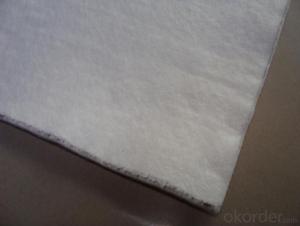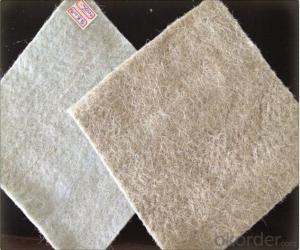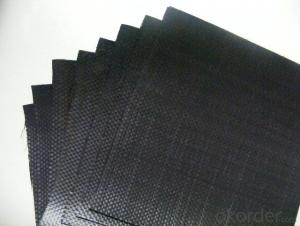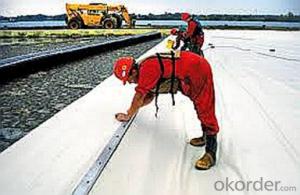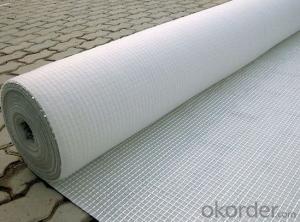Geotextil Para Drenaje Eco-friendly Antislip Non-toxic Home Textile Nonwoven
- Loading Port:
- Tianjin
- Payment Terms:
- TT OR LC
- Min Order Qty:
- 5000 g/m²
- Supply Capability:
- 10000 g/m²/month
OKorder Service Pledge
OKorder Financial Service
You Might Also Like
Packaging & Delivery
| Packaging Detail: | roll, fold |
| Delivery Detail: | within 15 days |

Specifications
PP Polyester woven geotextile,filtration,separation,reinforcement,erosion control
PP Polyester woven geotextile, and we sew woven geotextile into geotube,geobag, large area(panel) geotextile.
Geobag/tube:
specification: rectangle shape 4MX6M, cylinder diameter can be 3/4/5M, length to 30m, cubic shape .per your instructions.
Sewn from high tensile woven geotextile.

Woven Geotextile
Material:PP, PET
Color: white,other colors available
Width:1.06-3.7M
Weight: PP 200gsm-1400gsm,Polyester 90gsm-1500gsm
Tensile strength: PP 40KN/M-400KN/M,Polyester<500KN/M permeability:KX10-2-10-5 cm/s, K=1.0-9.9
Pore size: 0.07-0.5mm
Elongation: PP<35%, Polyester<15%< div="">
interweave method:plain, twill etc.
Benefits:filtration,separation,reinforcement,erosion control
Civil and environmental applications including highways, port facilities, reservoir, transport construction, waste and chemical management, subgrade engineering, coastal protection works, peninsula shoal engineering, subsurface drainage ,pile jacketing etc..
FAQ:
♦ Payment terms: by T/T or L/C |
♦ MOQ:2000 SQM |
♦ If you are interested in our products ,pls advice me the technical index,product weight etc,the more information the better..... |
- Q: The properties of woven geotextiles
- Product features: 1, with a reinforcement function: to stabilize the project in the course of prolonged use of the transfer occurred, and can be the role of the soil in the local stress transmission or assigned to a larger area. 2, with the role of separation: woven geotextile with different geotechnical structure to form a stable interface, in accordance with the requirements to play their own characteristics and the overall role. 3, the role of drainage filter: allow moisture to block the loss of sand particles, in the drainage of geotextiles on the poor water in the soil can play the water along the geotextile quickly discharged the purpose. 4, the geotextile and geomembrane used in two different pressures between the material can play a role in tension diaphragm. 5, with a block function: the geotextile placed in the flow of liquid with suspended particles in the channel to organize fine mud particles, and allow the liquid through the function. 6, play the role of cushion mat: the geotextile placed on the slope can prevent the soil particles due to the erosion of rain and the loss or planting turf.
- Q: Can geotextiles be used in mine tailings dewatering applications?
- Yes, geotextiles can be used in mine tailings dewatering applications. Geotextiles are commonly used in this context to separate solids from liquids, allowing for the efficient dewatering of mine tailings and the retention of solid particles. They provide effective filtration and drainage, reducing the moisture content of tailings and facilitating their disposal or further processing.
- Q: Can geotextiles be used for reinforcement in asphalt overlays?
- Yes, geotextiles can be used for reinforcement in asphalt overlays. Geotextiles act as a separator and provide reinforcement by distributing stress and preventing the mixing of different layers. They help in reducing reflective cracking and increasing the lifespan of the asphalt overlay.
- Q: What are the different geotextile installation techniques for erosion control blankets?
- There are several geotextile installation techniques for erosion control blankets, including anchoring, stapling, trenching, and pinning. Anchoring involves using stakes or pins to secure the blanket to the ground. Stapling uses staples or nails to attach the blanket directly to the soil. Trenching involves burying the edges of the blanket in a shallow trench to prevent water from getting underneath. Pinning involves using metal pins or stakes to secure the blanket to the ground. Each technique has its advantages and is chosen based on the specific needs and conditions of the erosion control project.
- Q: How are geotextiles used in construction?
- Geotextiles are used in construction to reinforce and stabilize soil, prevent erosion, and separate different layers of soil or aggregate materials. They are commonly used in road construction, landfills, retaining walls, and drainage systems to enhance the overall durability and performance of the structures.
- Q: Where to sell geotextiles
- Those who produce geotextile manufacturers are selling black geotextile. Black geotextile according to the use of a lot of specifications, the price difference is very large. The weight per square meter between about 50-1000g grams, the weight of different unit price is different, the inquiry directly asked how much money per ton. According to the use of distinction between the current market price per ton price between 5,000 yuan - yuan. For the conservation, isolation, insulation of the geotextile the cheapest. In the 5000 yuan / ton between. For the filter, soft base treatment, slope protection, reinforced decoration, and other purposes of the black geotextile most expensive in - yuan / ton. The same black color, but different uses, production processes and production costs are not the same.
- Q: Can geotextiles be used in coastal erosion control in beach nourishment projects?
- Yes, geotextiles can be used in coastal erosion control in beach nourishment projects. Geotextiles are permeable fabrics that can act as a filter and reinforcement, helping to stabilize the sand and prevent erosion. They can be used as a protective layer between the beach sediment and the underlying soil, preventing sand washout and promoting beach stability. Geotextiles are commonly employed in beach nourishment projects to enhance coastal resilience and mitigate erosion.
- Q: Geotextile production process
- Geotextile is a big class, there are many forms. Non-woven and non-woven. Non-woven and sub-filament and short wire; sub-mechanical entanglement, hot forming and chemical bonding. Spinning is also divided. Look at the relevant information.
- Q: What is the latest price of geotextile?
- Per ton of national standard short geotextile 7000-8000 yuan, filament geotextile per ton - yuan.
- Q: What are the challenges associated with the installation of geotextiles?
- Some challenges associated with the installation of geotextiles include ensuring proper alignment and placement of the fabric, securing it to the ground to prevent shifting or movement, and properly overlapping and connecting multiple pieces of geotextile to create a continuous barrier. Other challenges may include dealing with uneven or unstable soil conditions, working in difficult terrain or access areas, and ensuring the geotextile does not get damaged during the installation process. Additionally, the selection and installation of appropriate anchoring methods and the need for specialized equipment or expertise can also pose challenges.
Send your message to us
Geotextil Para Drenaje Eco-friendly Antislip Non-toxic Home Textile Nonwoven
- Loading Port:
- Tianjin
- Payment Terms:
- TT OR LC
- Min Order Qty:
- 5000 g/m²
- Supply Capability:
- 10000 g/m²/month
OKorder Service Pledge
OKorder Financial Service
Similar products
Hot products
Hot Searches
Related keywords

